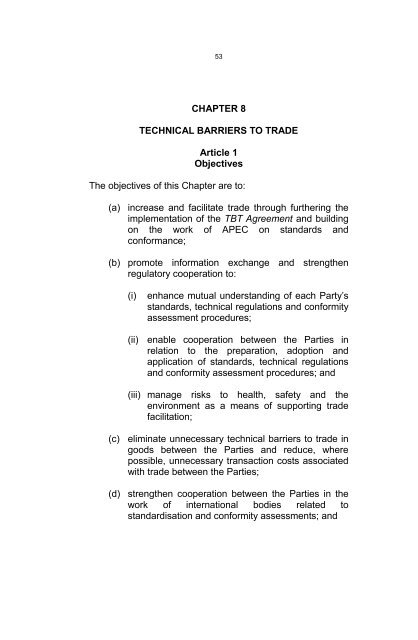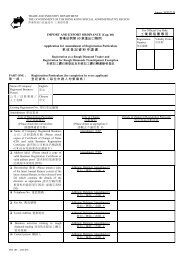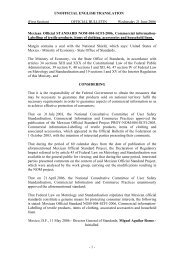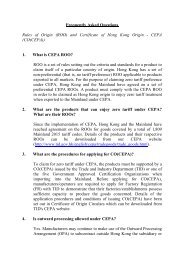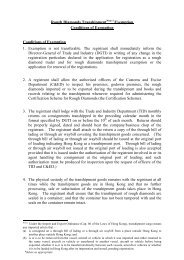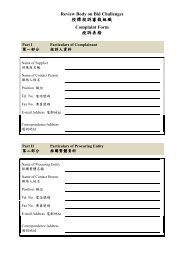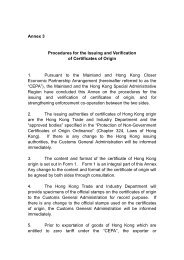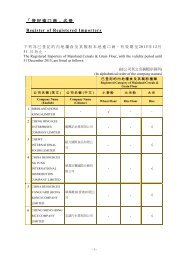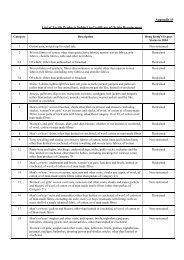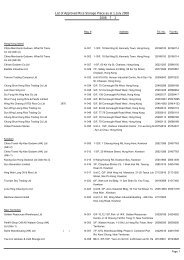Technical Barriers to Trade
Technical Barriers to Trade
Technical Barriers to Trade
You also want an ePaper? Increase the reach of your titles
YUMPU automatically turns print PDFs into web optimized ePapers that Google loves.
55(c) TBT Agreement means the Agreement on<strong>Technical</strong> <strong>Barriers</strong> <strong>to</strong> <strong>Trade</strong>, which is part of theWTO Agreement; and(d) technical regulations has the meaning set out inthe TBT Agreement and includes standards thatregula<strong>to</strong>ry authorities of a Party recognise asmeeting the manda<strong>to</strong>ry requirements related <strong>to</strong>performance-based regulations.Article 4Affirmation of the TBT Agreement1. The Parties affirm their existing rights and obligationswith respect <strong>to</strong> each other under the TBT Agreement.2. Nothing in this Chapter shall prevent a Party frompreparing, adopting or applying, in accordance with its rightsand obligations under the TBT Agreement, technicalregulations which are not more trade restrictive thannecessary <strong>to</strong> fulfil a legitimate objective, taking in<strong>to</strong> accountthe risks that non-fulfilment would create. Such legitimateobjectives are, inter alia, national security requirements, theprevention of deceptive practices, the protection of humanhealth or safety, animal or plant life or health, or theenvironment.Article 5International Standards1. The Parties shall use relevant international standards,guides or recommendations, or the relevant parts of them, <strong>to</strong>the extent provided in Articles 2 and 5 and Annex 3 of theTBT Agreement, as a basis for their technical regulations andrelated conformity assessment procedures, except whensuch international standards, guides or recommendations ortheir relevant parts would be an ineffective or inappropriatemeans for the fulfilment of the legitimate objectives pursued.
57Article 7Conformity Assessment Procedures1. The Parties shall seek <strong>to</strong> use, on a case by case basis,a broad range of mechanisms <strong>to</strong> facilitate the acceptance ofconformity assessment procedures conducted in the Area ofthe other Party, including:(a) promoting recognition of cooperative arrangementsbetween accreditation agencies located in eachother’s Area;(b) implementing unilateral recognition by one Party ofthe results of conformity assessments performed inthe other Party’s Area;(c) implementing mutual recognition of conformityassessment procedures conducted by bodieslocated in the respective Areas of the Parties;(d) recognising accreditation procedures of the otherParty for qualifying conformity assessment bodies inthat Party’s Area;(e) recognising the other Party’s designation ofconformity assessment bodies;(f) utilising relevant regional and internationalmultilateral recognition agreements andarrangements; and(g) accepting the declaration of conformity by a supplierin the other Party’s Area.2. The Parties shall intensify their exchange of informationon the mechanisms set out in Paragraph 1 and similarmechanisms with a view <strong>to</strong> facilitating the acceptance ofconformity assessment procedures and results.
59Article 8Cooperation for Regula<strong>to</strong>ry Effectiveness1. Recognising the important relationship between goodregula<strong>to</strong>ry practices and trade facilitation, the Parties shallcooperate in the areas of standards, technical regulationsand conformity assessment, on a case by case basis,including <strong>to</strong>:(a) promote good regula<strong>to</strong>ry practice based on riskmanagement principles;(b) improve the quality and effectiveness of theirtechnical regulations;(c) develop joint initiatives for managing risks <strong>to</strong> health,safety and the environment; and(d) build understanding and capacity <strong>to</strong> promote betterregula<strong>to</strong>ry compliance.2. The Parties shall implement this Article by establishingwork programmes under Article 10 <strong>to</strong>, inter alia:(a) exchange information on, inter alia:(i)regula<strong>to</strong>ry systems;(ii) incident analysis;(iii) hazard alerts;(iv) product bans and recalls; and(v) procedures, strategies and programmes forproduct surveillance activities; and(b) cooperate as mutually determined, on, inter alia:
60(i)the development of technical regulations;(ii) regula<strong>to</strong>ry reviews and implementation; and(iii) the development and implementation of riskmanagement principles, including productmoni<strong>to</strong>ring, safety, compliance andenforcement procedures.Article 9Transparency1. In order <strong>to</strong> enhance the opportunity for the other Partyand interested persons of the other Party <strong>to</strong> providemeaningful comments on a proposal <strong>to</strong> introduce a particulartechnical regulation or conformity assessment procedure, aParty publishing a notice under Article 2(9) or 5(6) of the TBTAgreement shall:(a) include in the notice a statement describing theobjective of the proposal and the rationale for theapproach that Party is proposing; and(b) transmit the notice via electronic communication <strong>to</strong>the other Party through its enquiry point establishedunder Article 10 of the TBT Agreement at the sametime as it notifies WTO members of the proposalpursuant <strong>to</strong> the TBT Agreement.2. Each Party shall allow at least 60 days from thetransmission of the notification under Paragraph 1(b) for theother Party and interested persons of the other Party <strong>to</strong> makewritten comments on the proposal.3. Where a Party makes a notification under Article 2(10)or 5(7) of the TBT Agreement, it shall at the same timetransmit that notification via electronic communication <strong>to</strong> theother Party through its enquiry point established under Article10 of the TBT Agreement.
614. Where goods are covered by an Annex or animplementing arrangement <strong>to</strong> which Article 11 applies and aParty takes a measure <strong>to</strong> manage an immediate risk that itconsiders those goods may pose <strong>to</strong> health, safety or theenvironment, it shall notify immediately the other Party,through the contact point designated under Article 10 of themeasure and the reasons for the imposition of the measure.5. A Party shall, at the request of the other Party, provideinformation regarding the objective of, and rationale for, astandard, technical regulation or conformity assessmentprocedure that the Party has adopted or is proposing <strong>to</strong>adopt.Article 10Implementation1. Each Party shall designate a contact point which shallhave responsibility <strong>to</strong> work collaboratively with the contactpoint of the other Party <strong>to</strong>:(a) coordinate participation in work programmes withpersons and organisations in their respective Areasthat have responsibility for accreditation ofconformity assessment bodies or relevant technicalregulations;(b) ensure appropriate steps are taken <strong>to</strong> address anyissue that the other Party may raise related <strong>to</strong> thedevelopment, adoption, application or enforcemen<strong>to</strong>f technical regulations and conformity assessmentprocedures;(c) enhance mutual cooperation in the developmentand improvement of technical regulations andconformity assessment procedures;(d) facilitate, where appropriate, sec<strong>to</strong>ral cooperationamong governmental and non-governmental
62regula<strong>to</strong>ry authorities, accreditation agencies andconformity assessment bodies in the Parties’ Areas;(e) exchange information, where appropriate, ondevelopments in non-governmental, regional andmultilateral fora engaged in activities related <strong>to</strong>standardisation, technical regulations andconformity assessment procedures; and(f)take any other steps the Parties consider will assistthem in implementing the TBT Agreement,implementing this Chapter and in facilitating trade ingoods between them.2. Each Party shall provide the other Party with the nameof the designated organisation that shall be its contact pointand the contact details of relevant officials in tha<strong>to</strong>rganisation, including telephone, facsimile, email and otherrelevant details.3. Each Party shall notify the other Party promptly of anychange in its contact point or any amendments <strong>to</strong> the detailsof the relevant officials.4. The Parties shall establish a Committee on <strong>Technical</strong><strong>Barriers</strong> <strong>to</strong> <strong>Trade</strong> (“TBT Committee”) consisting of officialsfrom the contact points and any other representatives of theParties <strong>to</strong> promote and moni<strong>to</strong>r the implementation andadministration of this Chapter. The TBT Committee shallmeet within one year of entry in<strong>to</strong> force of this Agreementand thereafter once every two years or as otherwise mutuallydetermined by the Parties. Meetings may be conducted inperson or via teleconference, video-conference or any othermeans mutually determined by the Parties. The TBTCommittee may also address issues throughcorrespondence, including via electronic communication.5. The functions of the TBT Committee shall include <strong>to</strong>:
63(a) identify and agree priority sec<strong>to</strong>rs and areas forenhanced cooperation, including giving dueconsideration <strong>to</strong> any sec<strong>to</strong>r-specific proposal madeby either Party;(b) where priority sec<strong>to</strong>rs or areas have been agreed,establish work programmes with clear targets,design structures and timelines;(c) moni<strong>to</strong>r the progress of work programmesestablished under subparagraph (b);(d) consult with a view <strong>to</strong> resolving any matter arisingunder this Chapter, in accordance with Article 12;(e) review this Chapter in light of any developments inrelation <strong>to</strong> the TBT Agreement, and developrecommendations <strong>to</strong> the Joint Commission foramendments <strong>to</strong> this Chapter in light of thosedevelopments; and(f) report <strong>to</strong> the Joint Commission on theimplementation of this Chapter, as it considersappropriate.6. The Parties shall ensure, <strong>to</strong> the extent possible, that thepersons and organisations in their respective Areas that haveresponsibility for relevant accreditation of conformityassessment bodies or relevant technical regulationsparticipate in work programmes and technical consultationswhere the TBT Committee has:(a) established a work programme under Paragraph5(b); or(b) been requested <strong>to</strong> undertake technicalconsultations under Article 12.
655. The Parties agree <strong>to</strong> maintain a programme of ongoingreview and enhancement of Annexes and implementingarrangements.Article 12<strong>Technical</strong> Consultations1. Either Party may request technical consultations with theother Party with the aim of resolving any matter arising underthis Chapter. Unless the Parties mutually determineotherwise, the Parties shall hold technical consultationswithin 60 days from the request for technical consultations.The technical consultations may be conducted in person orvia email, teleconference, video-conference or any othermeans mutually determined by the Parties.2. Where either Party has requested technicalconsultations pursuant <strong>to</strong> Paragraph 1, the other Party shall:(a) investigate the issues that gave rise <strong>to</strong> the requestfor consultations including whether there are anyirregularities in the implementation of its technicalregulations or conformity assessment procedures;(b) give positive consideration <strong>to</strong> any request <strong>to</strong>address any irregularities identified undersubparagraph (a); and(c) report back <strong>to</strong> the other Party on the outcome of itsinvestigations, stating its reasons.3. <strong>Technical</strong> consultations may be referred <strong>to</strong> the TBTCommittee by either Party for further consideration.4. Any action taken pursuant <strong>to</strong> this Article andconsultations held pursuant <strong>to</strong> Paragraph 5(d) of Article 10shall be without prejudice <strong>to</strong> the rights and obligations of theParties under Chapter 16 (Dispute Settlement) or under theWTO Dispute Settlement Understanding.


